The Lunar Reconnaissance Orbiter (LRO) and the Lunar Crater Observation and Sensing Satellite (LCROSS) launched together from Cape Canaveral Air Force, now Space Force, Station on June 18, 2009, atop an Atlas V launch vehicle. The primary mission of the LRO, managed by NASA’s Goddard Space Flight Center in Greenbelt, Maryland, involved imaging the entire Moon’s surface to create a 3-D map with ~50-centimeter resolution to aid in the planning of future robotic and crewed missions. In addition, LRO would map the polar regions and search for the presence of water ice. Although its primary mission intended to last only one year, it continues to operate after 15 years in lunar orbit. The LCROSS, managed by NASA’s Ames Research Center in California’s Silicon Valley, planned to further investigate the presence of water ice in permanently shaded areas of the Moon’s polar regions. The two components of LCROSS, the Centaur upper stage of the launch vehicle and the Shepherding Satellite, planned to deliberately crash into the Moon. Instruments on Earth and aboard LRO and the LCROSS Shepherding Satellite would observe the resulting plumes and analyze them for the presence of water.


Left: Lunar Reconnaissance Orbiter (LRO), top, silver, and Lunar Crater Observation and Sensing Satellite (LCROSS), bottom, gold, spacecraft during placement inside the launch shroud. Right: Launch of LRO and LCROSS on an Atlas V rocket.
The LRO spacecraft carries seven scientific instruments:
- the Cosmic Ray Telescope for the Effects of Radiation (CRaTER) to characterize the lunar radiation environment;
- the Diviner Lunar Radiometer Experiment (DLRE) to identify areas cold enough to trap ice;
- the Lyman-Alpha Mapping Project (LMAP) to search for ice in the lunar polar regions;
- the Lunar Exploration Neutron Detector (LEND) to create a map of hydrogen distribution and to determine the neutron component of the lunar radiation environment;
- the Lunar Orbiter Laser Altimeter (LOLA) to measure slopes and roughness of potential landing sites;
- the Lunar Reconnaissance Orbiter Camera (LROC) consisting of two-narrow angle and one wide-angle camera to take high-resolution images of the lunar surface; and
- the Mini Radio Frequency (Mini-RF) experiment, an advanced radar system to image the polar regions and search for water ice.
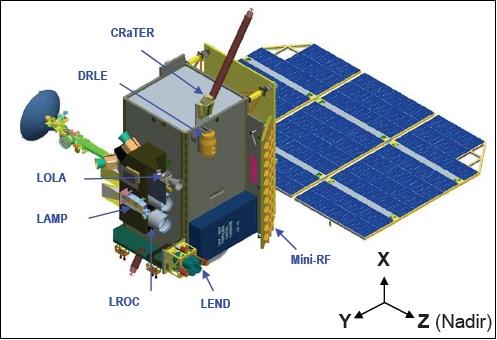

Left: Illustration of the Lunar Reconnaissance Orbiter and its scientific instruments. Right: Illustration of the Lunar Crater Observation and Sensing Satellite and its scientific instruments on panel at left.
The LCROSS Shepherding Satellite carried nine instruments – five cameras (one visible, two near-infrared, and two mid-infrared); three spectrometers (one visible and two near-infrared); and a photometer. They monitored the plume sent up by the impact of the Centaur upper stage.


Left: Illustration of the Lunar Reconnaissance Orbiter in lunar orbit. Right: Illustration of the Lunar Crater Observation and Sensing Satellite’s Shepherding Satellite at left and Centaur upper stage at right prior to lunar impact.
On June 23, 2009, after a four-and-a-half-day journey from Earth, LRO entered an elliptical polar orbit around the Moon. Over the next four days, four engine burns refined the spacecraft’s orbit and engineers on the ground began commissioning its instruments. The LROC returned its first image of the Moon on June 30 of an area near the Mare Nubium. On Sept. 15, 2009, LRO began its primary one-year mission to map the lunar surface from its science orbit 31 miles above the Moon.
On Oct. 9, 2009, first the Centaur upper stage followed five minutes later by the LCROSS Shepherding Satellite crashed into the Moon’s Cabeus Crater near the lunar south pole. Although the impacts created smaller plumes than anticipated, instruments detected signs of water in the ejected debris.
In September 2010, LRO completed its primary mapping mission and began an extended science mission around the Moon. On Dec. 17, NASA released the most detailed topographic map covering more than 98 percent of the Moon’s surface based on data from LRO’s LOLA instrument. The map continues to be updated as new data are received from the spacecraft. On March 15, 2011, LRO had made available more than 192 terabytes of data from its primary mission to the NASA Planetary Data System, or PDS, to make the information available to researchers, students, media, and the general public. LRO continues to deliver data to the PDS, having generated the largest volume of data from a NASA planetary science mission ever.


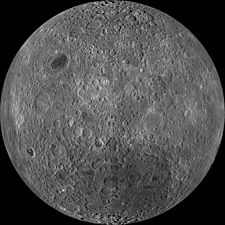
Left: First high-resolution image of the Moon taken by Lunar Reconnaissance Orbiter (LRO). Middle: Mosaic of LRO images of the Moon’s near side. Right: Mosaic of LRO images of the Moon’s far side.


Left: Mosaic of Lunar Reconnaissance Orbiter (LRO) images of the lunar north pole. Right: Mosaic of LRO images of the lunar south pole.
The LCROSS data showed that the lunar soil within shadowy craters is rich in useful materials, such as hydrogen gas, ammonia, and methane, which could be used to produce fuel for space missions. Large amounts of light metals, such as sodium, mercury, and silver, were discovered. The data revealed that there is perhaps as much as hundreds of millions of tons of frozen water on the Moon, enough to make it an effective oasis for future explorers.
Thanks to its unique vantage point in a low altitude lunar orbit, LRO’s camera has taken remarkably detailed images of all six Apollo landing sites. The detail is such that not only can the Lunar Module (LM) descent stages be clearly identified, but disturbances of the lunar soil by the astronauts’ boots, the shadows of the American flag are visible at five of the landing sites, and the Lunar Rovers from the last three missions are even visible. The scientific instruments, and in at least three of the landing sites, the U.S. flag left by the astronauts can be discerned. The flag at the Apollo 11 site cannot be seen because it most likely was blown over by the exhaust of the LM’s ascent stage engine when the astronauts lifted off. In addition to the Apollo landing sites, LRO has also imaged crash and soft-landing sites of other American, Soviet, Chinese, Indian, and Israeli spacecraft, including craters left by the deliberate impacts of Apollo S-IVB upper stages. It also imaged a Korean satellite in lunar orbit as the two flew within a few miles of each other at high speed. LRO also turned its camera Earthward to catch stunning Earthrise views, one image with Mars in the background, and the Moon’s shadow on the Earth during the total solar eclipse on April 8, 2024.


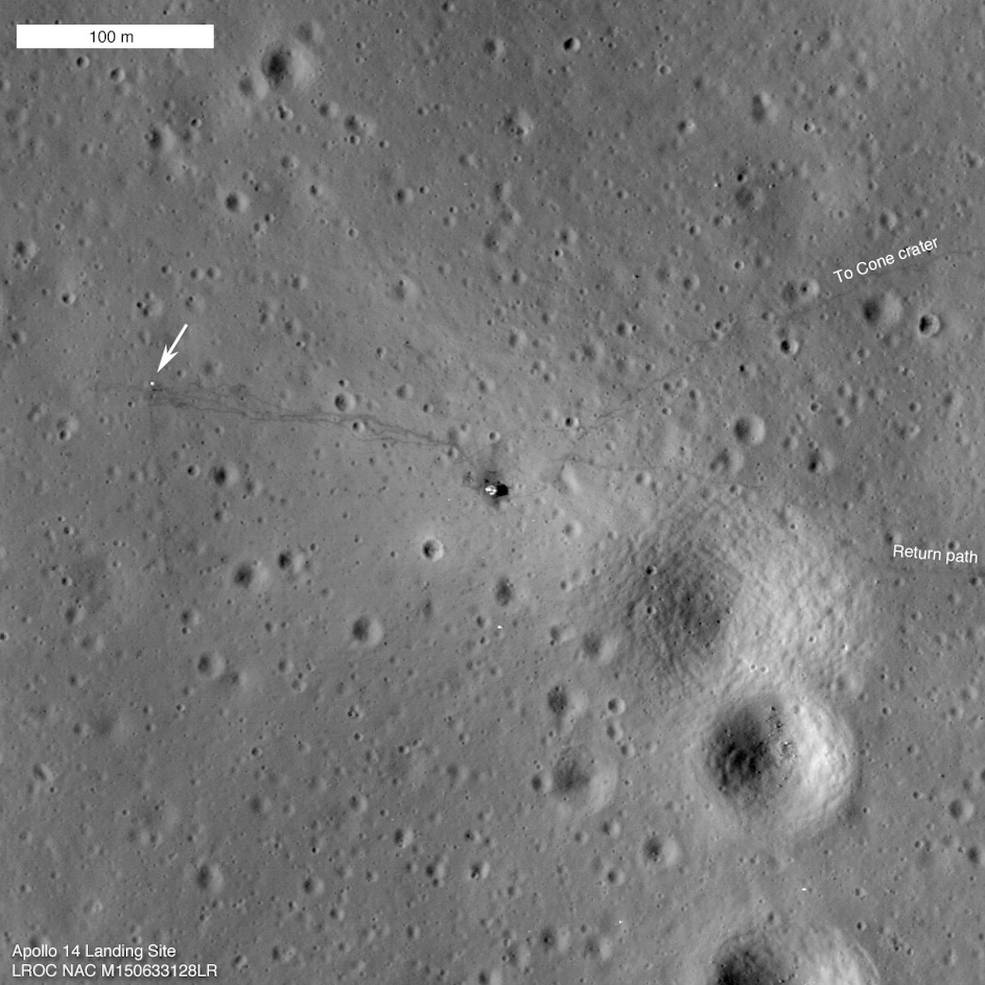
Lunar Reconnaissance Orbiter images of the Apollo 11, left, 12, and 14 landing sites.



Lunar Reconnaissance Orbiter images of the Apollo 15, left, 16, and 17 landing sites.
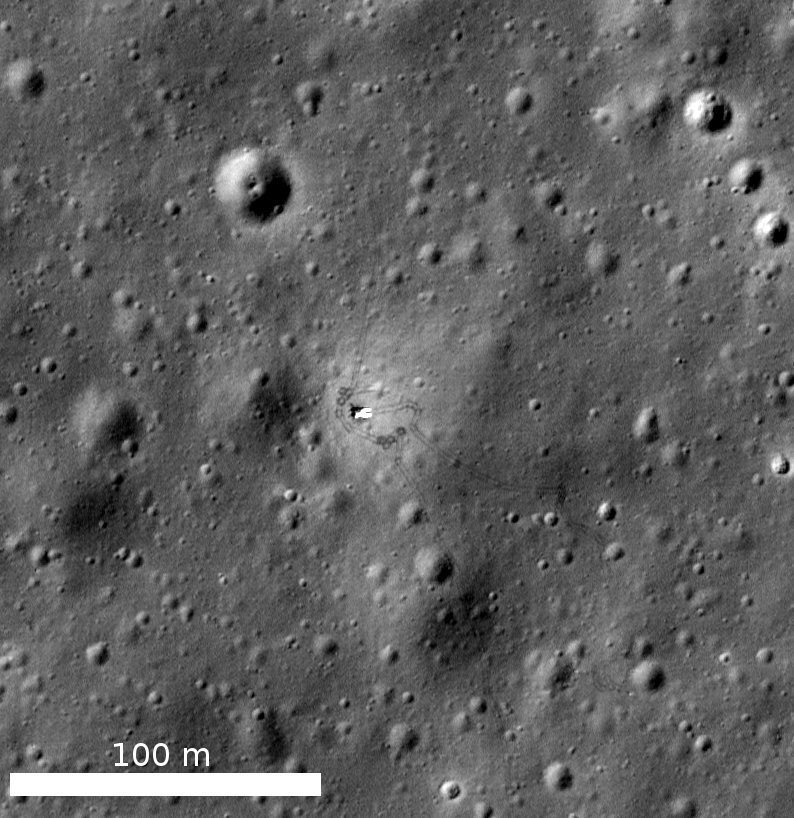


Left: Lunar Reconnaissance Orbiter (LRO) image of Luna 17 that landed on the Moon on Nov. 17, 1970, and the tracks of the Lunokhod 1 rover that it deployed. Middle: LRO image of the Chang’e 4 lander and Yutu 2 rover that landed on the Moon’s far side on Jan. 3, 2019. Right: LRO image of the Chandrayaan 3 lander taken four days after it landed on the Moon on Aug. 23, 2023.
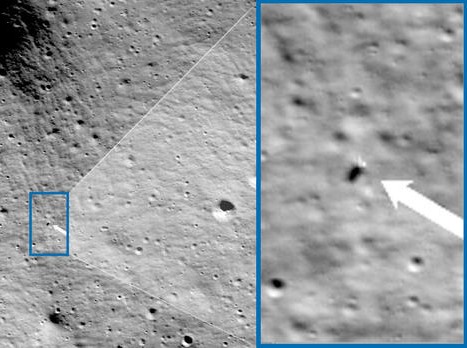


Left: Lunar Reconnaissance Orbiter (LRO) image of Odysseus that landed on the Moon on Feb. 22, 2024. Middle: LRO image taken on March 5, 2024, of the Danuri lunar orbiting satellite as the two passed within 3 miles of each other at a relative velocity of 7,200 miles per hour. Right: LRO image of the Chang’e 6 lander on the Moon’s farside, taken on June 7, 2024.



Left: Lunar Reconnaissance Orbiter (LRO) image of Earthrise over Compton Crater taken Oct. 12, 2015. Middle: LRO image of Earth and Mars taken Oct. 2, 2014. Right: LRO image of the total solar eclipse taken on April 8, 2024.
The LRO mission continues with the spacecraft returning images and data from its instruments. LRO has enough fuel on board to operate until 2027. The spacecraft can support new robotic lunar activities and the knowledge from the mission will help aid in the return of humans to the lunar surface.
